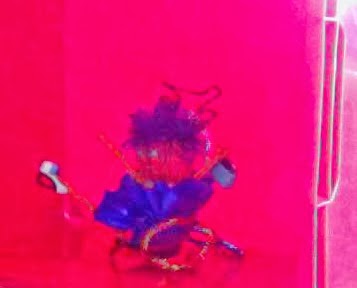20.45
The Caribbean Research Institute CARIRI investigated possibilities to mass produce raw forms with the use of pressing machines in the 1970s. Much of this project took place in Sweden in collaboration with the Saab Company
Another method of shaping the pan was attempted: by spinning. The pan was spun on a lathe-like device, and a roller on the end of a bar was used to sink the pan. While this did create pre sunk pans, a problem was that there would often be scratches and grooves in the steel
Since the steel is stretched and thin, any scratch will expand and can crack. Often drums have lettering embossed into the bottom
Brazing over the holes and grinding, will often fix the problems, without damaging the sound, but it has to be done nearly at the end of the sinking process, and well before any final shaping
A Swiss steel pan manufacturer (PANArt) researched the field of fine-grain sheet steel and developed a deep drawn raw form which was additionally hardened by nitriding. This process, and the instruments they called Pang, were presented at the International Conference of Steel pan and Science in Port-of-Spain in 2000
Electronic steel pans have also been developed. One such version is the E-Pan, invented by Salmon Cupid, who holds utility patents for it.[7] Another is the Percussive Harmonic Instrument (PHI)
The House of Flowers
by The Hollies in 1967 with "Carrie Anne".
Steelpans were introduced to the genre of Jazz Fusion by players such as Dave Samuels and Othello Molineaux in the 1980s, and Jonathan Scales in the 2000s. The sound of the steelpans adds a pleasant and accessible sound to an otherwise complex musical style. They are featured in the early fusion album Morning Dance by Spyro Gyra
The Caribbean Research Institute CARIRI investigated possibilities to mass produce raw forms with the use of pressing machines in the 1970s. Much of this project took place in Sweden in collaboration with the Saab Company
Another method of shaping the pan was attempted: by spinning. The pan was spun on a lathe-like device, and a roller on the end of a bar was used to sink the pan. While this did create pre sunk pans, a problem was that there would often be scratches and grooves in the steel
Since the steel is stretched and thin, any scratch will expand and can crack. Often drums have lettering embossed into the bottom
Brazing over the holes and grinding, will often fix the problems, without damaging the sound, but it has to be done nearly at the end of the sinking process, and well before any final shaping
A Swiss steel pan manufacturer (PANArt) researched the field of fine-grain sheet steel and developed a deep drawn raw form which was additionally hardened by nitriding. This process, and the instruments they called Pang, were presented at the International Conference of Steel pan and Science in Port-of-Spain in 2000
Electronic steel pans have also been developed. One such version is the E-Pan, invented by Salmon Cupid, who holds utility patents for it.[7] Another is the Percussive Harmonic Instrument (PHI)
The House of Flowers
by The Hollies in 1967 with "Carrie Anne".
Steelpans were introduced to the genre of Jazz Fusion by players such as Dave Samuels and Othello Molineaux in the 1980s, and Jonathan Scales in the 2000s. The sound of the steelpans adds a pleasant and accessible sound to an otherwise complex musical style. They are featured in the early fusion album Morning Dance by Spyro Gyra

No comments:
Post a Comment